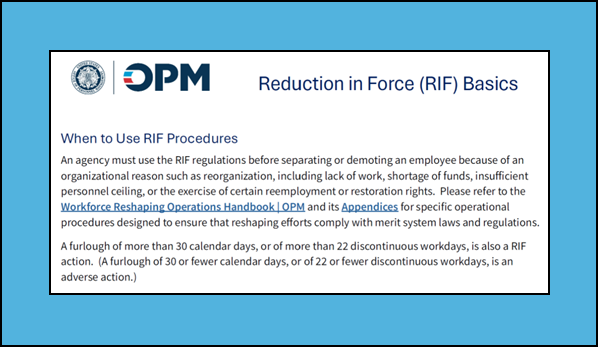What to know if you received a federal RIF notice
You may have heard that many federal employees received Reduction In Force (RIF) notices today. If you are one of them, try not to panic. RIFs are not new. They are a personnel action that agencies have taken in the past—usually when an agency could not maintain full payroll during a severe budget shortfall. Those past RIFs followed established procedures and timelines. And they offer a roadmap for how future RIFs could unfold.
What’s different about this year’s RIFs is the pace, breadth, and circumstances. Even now, though, federal agencies must still ensure that RIFs “comply with merit system laws and regulations.” That’s according to a March memorandum issued by the U.S. Office of Personnel Management (OPM). There are a few key points and procedural requirements from OPM’s memo that are also good to know:
People often think a RIF means being laid off. But losing your job is only one of the possible outcomes. Agencies can reassign an employee to an equivalent position in another office. Or they can demote the employee to a position at a lower pay grade. While these other outcomes may be undesirable, getting RIF’d does not necessarily mean forced separation from federal service, which is the greatest fear among most federal employees.
Receiving a RIF notice does not guarantee that you will be RIF’d. Let me say that again. Just because you received a RIF notice, that does not mean you will 100% be laid off, reassigned, or demoted. As OPM acknowledges, agencies are required to give 60 days’ notice before executing a RIF. (In some cases, 30 days.) Once you are put on notice and the 60 days lapses, the agency can then initiate a RIF action against you. Or they could do nothing, and you could keep working as usual.
Before implementing a RIF, agencies must establish Competitive Levels based on official position descriptions. Those Competitive Levels cannot be based on individual employees’ personal qualifications. Instead, the competitive levels categorize positions based on grade, classification series, and work schedule (such as part-time versus full-time). Within each Competitive Level, all positions have interchangeable qualifications and job duties. How an agency draws up the Competitive Levels in a RIF is hugely important. It can make the difference between you being one of a hundred people in the same RIF category, or the only person.
When conducting a RIF, agencies must consider four retention factors: tenure, veterans’ preference, total creditable federal service, and performance ratings. These are objective criteria. None of these factors considers an employee’s personal qualifications in determining whether to take a RIF action against them.
I know it can be scary to receive a RIF notice. My heart goes out to every federal employee who received one today. Try to stay calm and remember that a RIF notice does not automatically mean your federal career is over. If you need legal advice, consult an attorney about your specific situation. If you’d like to read the full OPM memo on RIF Basics to better understand the process, you can find it here.

